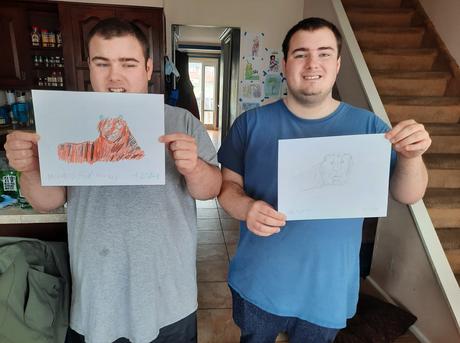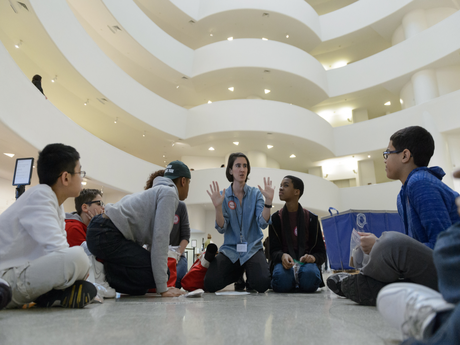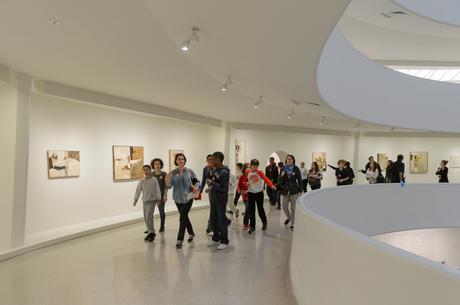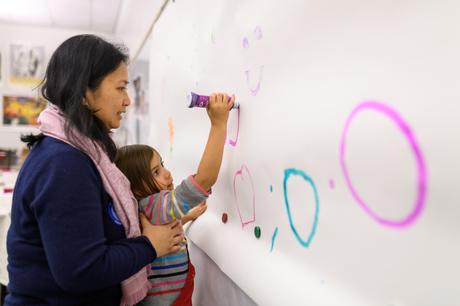by Melanie Adsit, Guggenheim For All
The Guggenheim Museum is committed to creating an accessible experience for all patrons and has developed several innovative programs to provide multiple points of access for diverse constituents. Our ongoing goal is to make the Guggenheim a welcoming place of creativity, respite, learning, and community for all visitors.
What is the Guggenheim doing for families with ASD?
Guggenheim for All (GFA), which began as a pilot program with Brooklyn Autism Center in 2010, has become a central part of the Guggenheim Museum’s programming. Guggenheim for All facilitates unique museum experiences for people with autism spectrum disorders (ASD) through school programs, family programs, visitor resources, and career development opportunities. School and family programs led by specially trained educators use art activities to help students with ASD develop their social and communication skills and become comfortable with new learning environments and routines, while also encouraging them and their caregivers to consider the museum as a welcoming and non-judgmental place for engagement. Visitor resources produced by the museum include “Visiting the Guggenheim”, a social narrative guide to the Guggenheim, available online or in downloadable print form, as well as a sensory map of the museum and sensory supports to be used in the museum galleries. Career development opportunities include an internship and apprenticeship for young adults with autism to experience the museum as a workplace and develop job skills.
After nine years of successful engagement through Guggenheim for All, the museum has received multiple requests from institutions across the U.S. for insight into launching like-programming, the Guggenheim Museum saw a critical need for leadership in developing a broader, meaningful museum autism program model. As museums work to develop programming opportunities for this growing audience, resources and research remains limited; there was a real need for further research and development of resources that link best practices in museum education with best practices in the field of education for individuals with autism. The Guggenheim decided in 2018 to fill this role by both conducting the research and creating a replicable, scalable program model in the form of a free digital curriculum and toolkit designed to provide a framework and resources for implementation and adaptation by other cultural institutions. In this way, the Guggenheim Museum seeks to generate a collective that over time, can engage in innovative ways with children and adults on the autism spectrum, and share best practices to further fortify autism programming in arts organizations nationally and globally.
Who benefits by this program?
By using the arts to support the strengths of individuals with autism, museums are uniquely poised to help students connect with people and works of art through communication about art and art-making. Many of the learning strengths common to individuals with autism seem to be a natural fit with the visual arts. Museum education utilizes object-based and hands-on teaching techniques; the concrete visual nature of these experiences can scaffold conversation and interpersonal interactions for students who often exhibit a concrete visual learning style. Connecting young people with autism to the arts through their own strengths and interests allows them to develop their skills and talents in a creative and authentic way. Museum education is poised to provide a constructivist learning experience that builds on the learning strengths characteristic of people with autism while indirectly addressing the areas of socialization and communication with which these individuals often need support. However, a specialized methodology to teach individuals with autism in the museum does not exist; current practice is focused on adapting museum education techniques for neurotypical learners. While the learning strengths found to be specific to individuals with autism point to an educational method that is visual, little research exists on how the visual arts can be utilized in a strengths-based manner.
What are they doing for families outside NYC?
GFA family programs have filled every month, and are attended by families both local and global. Participants have joined from across the USA as well as from England, Wales, Korea, and the Netherlands, and are developing friendshipsand connecting with peers around the globe. Our April 2021 GFA family program featured Myasia Dowdell, an artist with autism who is represented by LAND gallery. This event filled to capacity, and inspired participants to create their own work and support the artist herself. A parent wrote: “That was absolutely amazing! My son and I enjoyed it so much. We loved hearing about the artists thought process and seeing the colorful and arresting artwork. I wanted to ask if there was somewhere to purchase Myasia’s artwork. Specifically, the Michael Jackson piece. Many thanks for a special morning!” Based on this program’s success, the museum hopes to highlight more artists with autism in upcoming GFA family programs.
The museum is also putting together a virtual exhibition of work created by GFA students, organized by our GFA apprentice and intern, that will be live on the museum’s website and showcase the talents of participants in the program. We are also planning our first in-person GFA family event to be held in Central Park in June. The event will be held in collaboration with Kansas Children’s Discovery Center, a children’s museum in Topeka with a dedicated autism program. The program and will focus on nature and architecture and encourage families to connect with peers across distancethrough art.
How can I get involved ?
GFA virtual programs will be evaluated through a study with Seaver Autism Center for Research and Treatment at Mount Sinai during 2021. The study will examine the effectiveness of the GFA training program by assessing educator fidelity to a training module and examine student and caregiver expectations and satisfaction. The data generated by this study will both validate the practices we are using in GFA programs and also to add a formal evaluation component tothe GFA Toolkit.
Learn more HERE.




